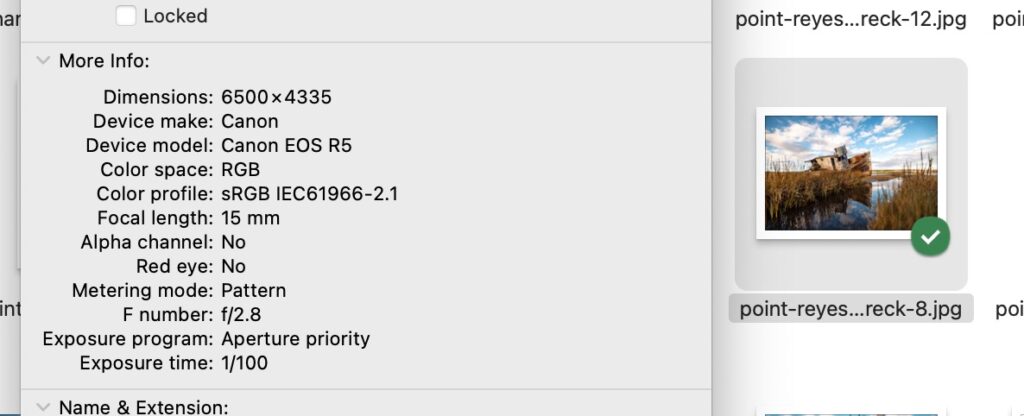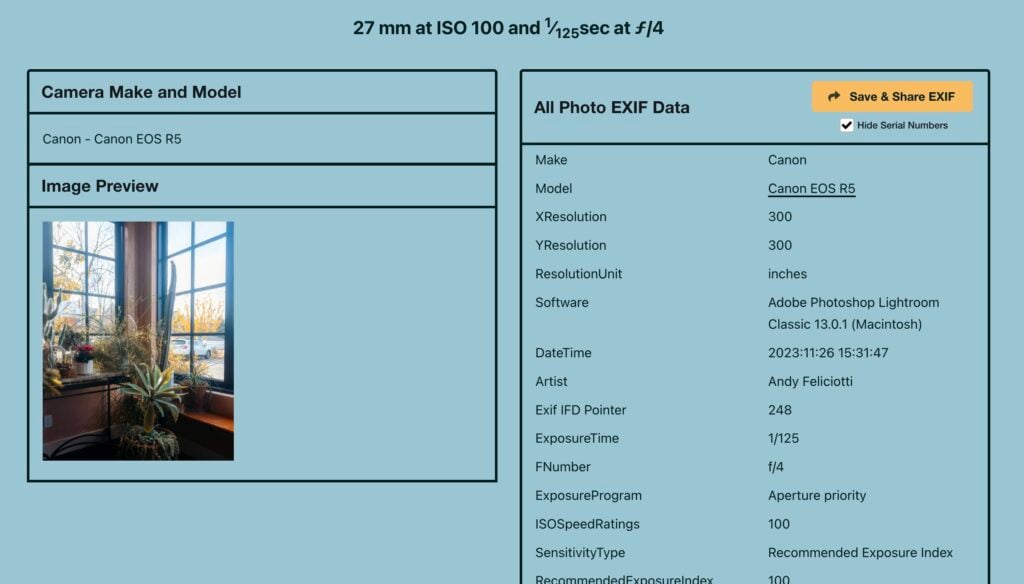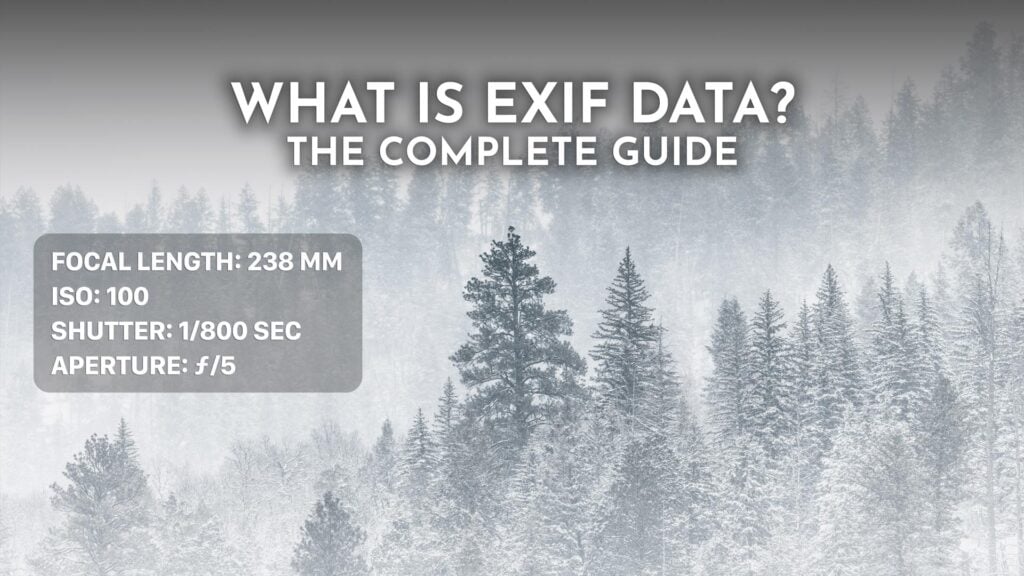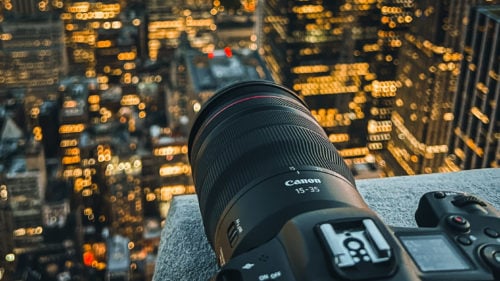As photographers, our journey is not just about capturing moments but understanding the gear behind each photo. In this post we’ll dive into the EXIF data, a feature ingrained in digital photography that often goes unnoticed yet holds a wealth of information. This comprehensive guide will explore what EXIF data is, its significance, and how you can use it to enhance your photographic expertise.
Let’s dive in.
Table of contents
What is EXIF Data?
EXIF, short for Exchangeable Image File Format, is an essential part of digital photography. It’s a standard that embeds metadata into your photos, providing a detailed account of various aspects of each image. This usually includes settings of the photo like shutter speed and white balance. Typically most digital cameras embed EXIF data into all photos taken on a camera.
EXIF data typically includes:
- Camera Specifications: Model, make, and the software used.
- Shooting Details: Camera settings such as shutter speed, aperture, ISO, white balance, and focal length.
- Geographical Information: GPS data including coordinates, if available.
- Time and Date: The exact moment when the photo was captured.
- Copyright Information: If set it’ll also write the photographers name into the metadata.
Diving deeper, EXIF data provides insights into the technicalities of each shot. This includes comprehensive details like metering mode, flash usage, image compression type, and pixel dimensions. It’s like having a behind-the-scenes look at your photography settings, giving you a chance to analyze and learn from each exposure.
EXIF Data Across Various File Formats
EXIF data isn’t limited to a single image format. It spans across various file types:
- JPEG and JPG: Popular formats that embed a wide range of EXIF data.
- RAW: The unprocessed ‘negatives’ of digital photography, RAW files contain extensive EXIF data, crucial for post-processing.
- TIFF: A format often used in professional settings, supporting a comprehensive array of EXIF information.
When using a photo editing app like Adobe Lightroom you can filter all of your photos based on their EXIF data. For example you can filter all photos you’ve taken with a specific lens.
How to View and Utilize EXIF Data

Accessing EXIF data is straightforward and can be done through:
- Operating Systems: Both Windows and macOS offer native ways to view EXIF data. In Windows, right-clicking on a photo and selecting ‘Properties’ reveals this information. On macOS, using ‘Show Inspector’ in Preview does the trick. I’ve noticed on macOS at least it won’t show every single EXIF item but just a few key elements.
- Photo Editing Software: Tools like Adobe Lightroom and Photoshop not only display but also let you edit this data.
- Dedicated EXIF Viewers: For an in-depth analysis, dedicated EXIF viewing software or online tools like Online EXIF Viewer provide a comprehensive look at the metadata.

Keep in mind that if you find a photograph online many web servers remove EXIF data to improve the size of images. This includes many large websites and social media sites. So if no EXIF data is available on an image you find it doesn’t mean an image never had EXIF data. For example when sharing images from iPhone Apple has an option to remove the location data of the image from the image’s EXIF data.
Why EXIF Data Matters in Photography
EXIF data is can be more than just numbers and technical jargon. It has practical applications in photography:
- Improving Photography Skills: By examining the EXIF data, you can understand what camera settings were used and how they affected the outcome of your photos. This is especially useful in mastering challenging conditions and experimenting with different settings. Read my tips to improve your photography skills.
- Organizing and Cataloging: EXIF data enables you to sort and manage your photo library efficiently, using criteria like date, time, camera model, or even geographical location. This makes tools like Lightroom great for finding specific photos quickly.
- Informed Post-Processing: When editing photos, EXIF data provides crucial information about the original conditions, allowing for more informed adjustments in software like Photoshop and Lightroom.
The Privacy Aspect of EXIF Data
While EXIF data is helpful, it also raises privacy concerns, particularly with geotagging features. Many Canon, Nikon, and Sony cameras don’t embed this information since they don’t have GPS capabilities. Sharing photos online with embedded location data can inadvertently reveal your whereabouts. It’s crucial to understand how to manage this aspect of EXIF data:
- Removing Sensitive Data: Tools like imagy allow you to selectively remove EXIF data, such as GPS coordinates, to protect your privacy.
- Disabling Geotagging: Many cameras and smartphones offer the option to disable geotagging to prevent the recording of location EXIF metadata.
If you are more technical using a tool like ExifTool will allow you to view and modify EXIF data with command line.
Leveraging EXIF Data for Creative and Professional Growth
EXIF data can be a powerful tool for both creative growth and professional development in photography:
- Analytical Learning: Compare EXIF data across different shots to understand how changes in settings like ISO speed or shutter speed affect your images. You may also ask for a friend’s EXIF data from a photo to have a great understanding of the settings behind a picture.
- Professional Use: For professional photographers, EXIF data can serve as evidence of authenticity and originality, especially important in contexts like photojournalism or contests.
Conclusion
EXIF data is a treasure trove of information that can significantly impact a photographer’s workflow, from shooting to post-processing. By harnessing the power of this metadata, photographers can gain deeper insights into their work, enhance their skills, and maintain control over their digital privacy. As digital photography continues to evolve, the role of EXIF data in enriching the photographic experience becomes ever more pivotal.
As you can see, EXIF data is important to unlocking the full potential of your digital photos. If you want to view your photos’ EXIF data, I built the site Online EXIF Viewer as an interactive and user-friendly tool to view and share EXIF data from your photos.



